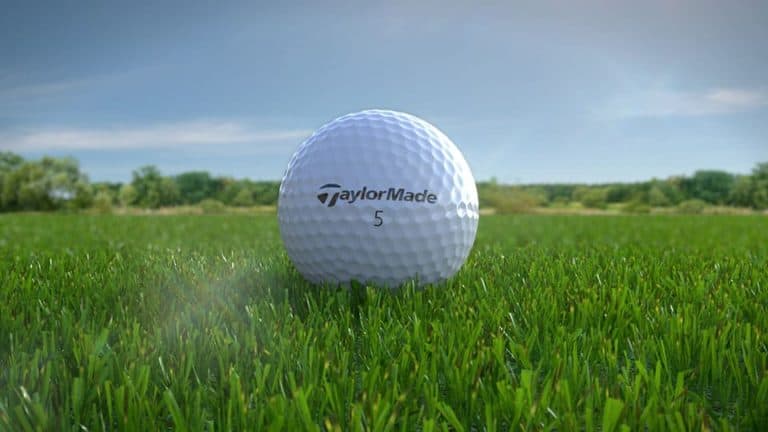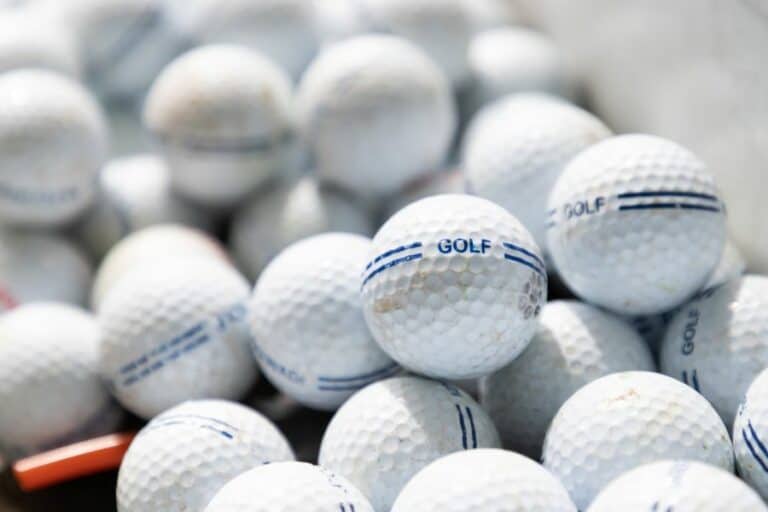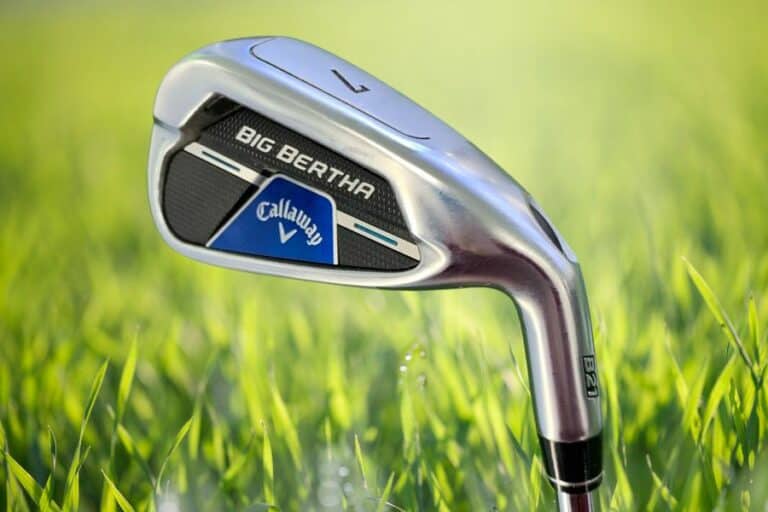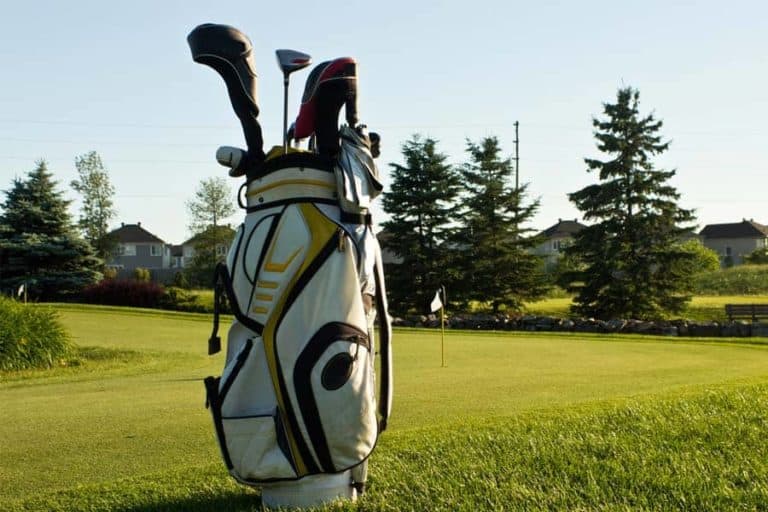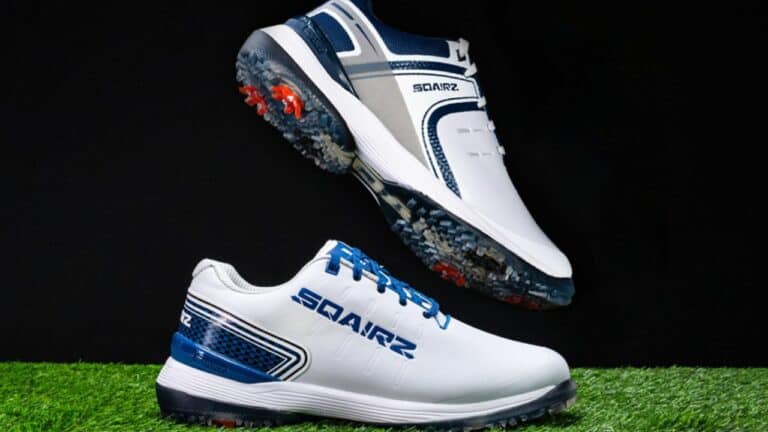What Golf Ball Should I Use: Top Criteria To Consider

All golfers know that even the subtlest change in equipment can change the game’s dynamics. Here’s all you need to know about golf balls for a better game.
A low-compression soft golf ball is ideal for a slow swinger to maximize distance. In contrast, a fast swinger should go for a harder golf ball as it offers higher compression to produce maximum distance.
Given below are detailed comparisons of the primary characteristics of golf balls. These will help you determine which is the best golf ball for you.
What golf ball should I use: Soft golf balls vs. hard golf balls
Soft golf balls have a soft core and cover that give you more control over your shots. A soft golf ball is best suited for golfers whose swing speed is under 100 mph or even 90 mph.
Moreover, it will make chips and wedge shots easier. Soft golf balls generate less spin and are best for shaping shots.
On the other hand, hard golf balls come with a harder core and cover, making them ideal for experienced golfers with high swing speed that is above 105 mph. A hard golf ball offers more control for backspin and spins around the greens.
Choosing in terms of construction, compression, and cover
Construction, compression, and cover of the golf ball are the three most vital aspects to analyze when selecting the ideal ball.
Construction: Multi-layer golf balls vs. Two-piece golf balls
Golf balls come in different construction designs: one-piece, two-piece, and multi-layered. The number of layers in the golf ball significantly impacts the performance. The two-piece and multi-layered golf balls are the most commonly used golf balls.
One-piece: Golf balls with this kind of construction use a single piece of material. Moreover, they tend to be extremely firm and are primarily used on miniature golf ranges rather than on a course.
Two-piece: On the other hand, two-piece golf balls are a simpler construction designed for beginners or amateurs looking to maximize distance on their drives.
Two-piece golf balls tend to be more forgiving than the others as they have a lesser spin. They have one hardcore and a durable cover to provide maximum carry on each shot.
Moreover, a two-piece soft golf ball gives the player more control while putting. Lastly, they are cheaper than the other multi-layer golf balls.
Callaway Supersoft is one of the most preferred two-piece balls on the market.
Multi-Layer: Multi-layer golf balls have a more complex construction than two-piece balls. They are designed for experienced players.
The multi-layer golf ball construction can have a 3-piece, 4-piece, or 5-piece construction. These golf balls are usually premium golf balls having high compression meant for fast swingers.
They typically consist of several layers, including a soft core, which can help you hit longer distances, and an outer cover that gives control to your shots.
Titleist Pro V1 is a 3-piece golf ball that has been most commonly used by professional golfers.
Compression: Low vs. High compression
The golf ball’s compression refers to the core’s firmness when struck by your club. The more your ball is compressed, the further it will travel because of the energy transferred onto it.
Low compression (80 and below rating):
A low-compression golf ball has a soft core and is designed for slower swing speeds.
They generate a higher launch angle, are more forgiving, and have a lesser side spin, giving you more ball speed and distance on each shot.
Thus, if you have a slower swing speed, low-compression golf balls are recommended to maximize your distance.
High compression balls (100 or above rating):
High-compression golf balls have a harder core and are designed for faster swing speeds. These balls generate a lower launch angle with optimal spin rates, which can help experienced players with more precise control over their shots.
Cover material: Urethane vs. Surlyn
The golf ball’s cover material will interact most with the clubface and affect your shots’ spin, feel, and control.
Urethane: These covers provide a soft feel, good greenside control, and more spin.
Urethane covers provide better overall performance than Surlyn covers however are less durable.
Here are some of the most widely used urethane golf balls:
- Titleist Pro V1
- Titleist Pro V1x
- Srixon Z-Star XV
Surlyn: The surlyn covers are firmer and less expensive than urethane covers. These are the general 2-piece golf balls meant for high handicappers. They provide more distance and, are less affected by the wind/ have a lesser spin.
However, they don’t spin as much on short shots and are highly durable. Here are some of the most widely used Surlyn golf balls:
- Titleist Velocity
- Volvik Vista iS
- Callaway Hex Warbird
4 criteria to choose golf balls:
The four most important factors to consider when selecting the right golf ball are your swing speed, distance, and handicap.
1. Swing speed
If you have to choose a golf ball based on your swing speed, a slow swinger should opt for a softer, low-compression ball to maximize the distance.
On the other hand, if you are a fast swinger, high compression, harder golf ball, you will be able to fully compress the ball to produce maximum distance.
2. Distance
If you have a swing speed of over 100 mph or if the distance is what you need most out of your game, choose a ball with a multi-layer construction and high compression.
Choose a ball with two-piece construction and low compression for those with slower swing speeds or looking to maximize distance.
Choose hard golf balls with a lesser spin if you aim for more distance. Given below are two golf balls that are known to provide distance.
- Titleist AVX
- Callaway Chrome Soft X LS
3. Handicap
If your handicap is over 15, use a hard ball that provides some spin and good distance.
If your handicap is 5-15, use a ball that gives you a higher trajectory because a higher launch will help your game.
4. Spin
Low spin: These balls are best suited for players that slice the ball or struggle with distance. Low-spin balls tend to decrease the side spin of the shots by allowing the ball to fly in a straight path through the air.
Mid spin: It is suitable for all players. This is because these balls incorporate the best of both distance and feel.
High spin: For players that hit the ball right to left with a draw, a high-spinning golf ball could be the best for their game as it gives a longer carry.
Tips to consider before purchasing a golf ball
Here are some points you must consider before you make the purchase.
- If you are satisfied with the distance of the ball, remember to try out the short game and especially check its short game spin.
- Buy a few dozen balls at once so you can practice with them and get used to their performance before heading out on the course.
- Read reviews online before purchasing, as they can help determine how well the ball works for different players.
- Premium golf balls can be way too expensive for beginners and intermediate players who likely won’t benefit from the technology and extra performance they offer. Thus it is important to pay attention to the price.
- If you are an amateur or high handicapper, you should look for a ball that offers maximum distance and forgiveness. If you’re an advanced player, you might consider investing in a premium golf ball with lower spin rates and increased control. This makes it important to find out the kind of golfer you are.
- A softer golf ball will perform better in colder temperatures because it will compress more easily. However, it may lose distance. In warmer conditions, a harder golf ball will be more efficient as it won’t compress as much, and the club head will transfer more energy to the ball. Thus, consider the temperature you play in before choosing a ball.
- It is critical to know your own game because knowing how far you hit each club is the key to choosing the right golf ball. If you know that you hit your driver 270 yards on average, you don’t want to use a golf ball optimized for maximum distance.
- When shopping for a golf ball, always pay attention to the feel and sound it makes when you hit it off the clubface. The right golf ball will have a soft feel but still provide good distance and control.
- If you’re serious about improving your game, consider getting fitted for a golf ball. A professional club fitter will be able to analyze your swing on a launch monitor. This will give you the numbers that might help you know the difference in your launch, trajectory, and spin rate on long and short shots. On the basis of these numbers, the fitters can recommend the best golf ball for you.
- Trying out different types of golf balls at the range is the best way to find the one that works best for you. Hit several golf balls with each one and see which ones give you the most distance and accuracy.
- If you’re still unsure which golf ball is right for you, talk to your local pro or teaching professional. They can help you make an informed decision about which ball will best suit your game.
- Reading up on product reviews from trusted sources can help you find the right golf ball for your game. Many websites and magazines have detailed reviews of different types of golf balls to help you make an informed decision.
- Finally, always ensure that the USGA (United States Golf Association) approves the golf ball you buy. This ensures that it meets the governing body’s standards and is suitable for use on the course.
Conclusion
There are many factors to consider while choosing a golf ball. However, there is no one-size-fits-all solution when selecting a golf ball for your game. The best way to find the right ball for you is to try various golf balls, evaluate their course performance and consult a professional if needed.




